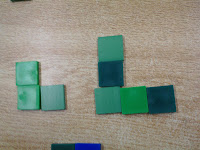“A mathematician,
like a painter or poet, is a maker of patterns. If his (or her) patterns
are more permanent than theirs, it is because they are made with ideas.”
G.H. Hardy, the famous British mathematician, wrote the above in his book A Mathematician's Apology (though I added the 'or her' in italics). I often ask students and adults what is Math the study of and whilst most say something along the line of 'the study of numbers' very few say what Hardy was getting at:
Math is the study of patterns.
Sometimes it is patterns in numbers (and these patterns can help us compose and decompose numbers as well as operate with them). Sometimes it is patterns in shapes, or how we measure things. Sometimes it is patterns in data. When I tell students this it is very liberating because human beings are born with the capacity to spot patterns (as explained in Professor Brian Butterworth's book The Mathematical Brain).
So we wanted to see how Grades 5 and 6 students would make their own patterns. Our original plan was to give students the first three terms of a pattern and then get them to predict the tenth term. I gave them the first term (shown below) and then went around each pair just to check that they had made it correctly on their desk.
What we noticed happening though was that students started doing the second term themselves, even though I had not told them to.
I know. The cheek of it!
But here are some of their examples:

This was the pattern we had expected. What we got was more interesting. Students could now be asked to look at other students' work and to describe the pattern as well as predict what the tenth term would look like. The students' conversations were full of reasoning and proving based on the variety of patterns that they had created. It was so much better than forcing them all to work with the same pattern.
So we were a bit surprised when we tried this exact same approach in a different class the next week. Just about all the students created the L-shaped pattern and the conversations weren't as rich:
"What's your pattern rule then?....Oh it's the same as mine. Wow."
So we quickly opened it up and asked them to create their own patterns without giving them the first term. This is what we got:
Now, the conversations were a lot richer. I am convinced that this was a result of the greater variety in the patterns.
So the lesson learned was this:
Students must be allowed to create their own patterns so that they will develop the ability to ask questions about other students' patterns.
So we were a bit surprised when we tried this exact same approach in a different class the next week. Just about all the students created the L-shaped pattern and the conversations weren't as rich:
"What's your pattern rule then?....Oh it's the same as mine. Wow."
So we quickly opened it up and asked them to create their own patterns without giving them the first term. This is what we got:
Now, the conversations were a lot richer. I am convinced that this was a result of the greater variety in the patterns.
So the lesson learned was this:
Students must be allowed to create their own patterns so that they will develop the ability to ask questions about other students' patterns.











No comments:
Post a Comment